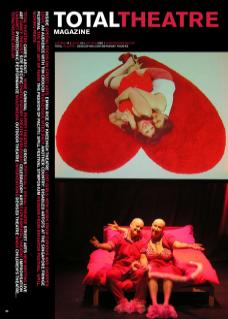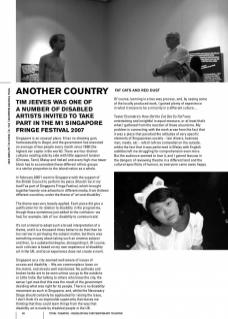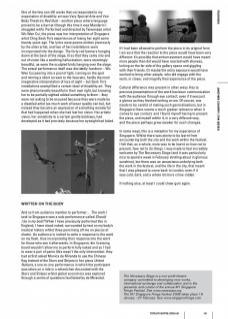Singapore is an unusual place. It has no chewing gum, homosexuality is illegal, and the government has executed an average of two people every month since 1990 (the highest per capita in the world). There are four distinct cultures existing side by side with little apparent tension (Chinese, Tamil, Malay and Indian) and every high-rise tower block has to accommodate these different ethnic groups in a similar proportion to the island nation as a whole.
In February 2007 I went to Singapore with the support of the British Council to perform my piece Should i be in my bodi? as part of Singapore Fringe Festival, which brought together twenty-one artworks in different media, from thirteen different countries, under the theme of ‘art and disability’.
The theme was very loosely applied. Each piece did give a justification for its relation to disability in the programme, though these sometimes just added to the confusion: we had, for example, talk of ‘our disability to communicate’.
It’s not criminal to adopt such a broad interpretation of a theme, and it is a thousand times better to do that than be too narrow in portraying the subject matter, but there was something uneasy about taking such an emotive subject and then, to a substantial degree, disregarding it. Of course, such criticism is based on my own experience of disability art in the UK, and local experience does not create a norm.
Singapore as a city seemed well aware of issues of access and disability – lifts are commonplace (even on the metro), and streets well maintained. No potholes and broken kerbs are to be seen unless you go to the outskirts or Little India. But talking to others who knew the city, the sense I got was that this was the result of the government deciding what was right for its people. There is no disability movement as such in Singapore, and, whilst the Necessary Stage should certainly be applauded for raising the issue, I don’t think it’s an imperialist superiority that leaves me thinking that they could learn things from the way that disability art is made by disabled people in the UK.
Fat Cats and Red Dust
Of course, learning is a two way process, and, by seeing some of the locally produced work, I gained plenty of experience in what it means to be a minority in a different culture…
Teater Ekamatra’s How Did the Cat Get So Fat? was entertaining and insightful in equal measure, or at least that’s what I gathered from the reaction of those around me. My problem in connecting with the work arose from the fact that it was a piece that parodied the attitudes of very specific elements of Singaporean society – taxi drivers, business men, maids, etc – which left me somewhat on the outside, whilst the fact that it was performed in Malay with English subtitles left me struggling for comprehension even more. But the audience seemed to love it, and I gained lessons in the dangers of reviewing theatre in a different land and the cultural-specificity of humour, so everyone came away happy.
One of the few non-UK works that corresponded to my expectation of disability art was Very Special Arts and Van Body Theatre’s Red Dust – another piece where language proved to be a barrier (though this time it was Mandarin I struggled with). Performed and directed by Taiwanese artist Wu Wen Cui, the piece was her interpretation of Singapore artist Chng Seok Tin’s experiences of losing her sight some twenty years ago. The lyrics were poems written previously by the older artist, and two of her installations were incorporated into the design. The forty red banners hanging down at the back of the stage, lit so that they came into and out of vision like a soothing hallucination, were stunningly beautiful, as were the sculpted birds hanging over the stage. The actual performance itself was decidedly hundrum – Wu Wen Cui peering into a pool of light, running on the spot and miming a silent scream to the heavens, hardly the most imaginative interpretation of loss of sight – but Seok Tin’s installations exemplified a certain ideal of disability art. They were phenomenally beautiful in their own right, but knowing her to be partially sighted added something to them – they were not asking to be excused because they were made by a disabled artist (as much work of lower quality can be), but instead they became an expression of something wonderful that had happened when she had lost her vision. Her artistic vision, her sensitivity to a certain gentle boldness, had developed as it had precisely because her eyesight had failed.
Written on the Body
And so from audience member to performer… The work I took to Singapore was a solo performance called Should I be in my bodi? When I have previously performed this in England, I have stood naked, surrounded by text on my body’s medical history whilst three pens hang off me on pieces of elastic. An audience is invited to write a response to the work on my flesh, thus incorporating their response into the work for those who see it afterwards. In Singapore, the licensing board wouldn’t allow me to perform fully naked and so I had to wear a pair of pants (this wasn’t the only intervention: they had at first asked Monica de Miranda to use the Chinese flag instead of the Stars and Stripes in her piece United Nations, a one-to-one performance in which the participant was taken on a ride in a wheelchair decorated with the Stars and Stripes whilst global economics was explored through a series of questions facilitated by de Miranda).
If I had been allowed to perform the piece in its original form I am sure that the reaction to the piece would have been very different: it’s possible that embarrassment would have meant more people than did would have reacted with shyness, lurking on the far side of the gallery space and giggling with their friends. Or maybe the extra exposure would have worked to bring other people, who did engage with the work, in closer, and magnify their experience of the piece.
Cultural difference was present in other ways. Key to previous presentations of the work has been communication with the audience through eye contact; even if it was just a glance as they finished writing on me. Of course, one needs to be careful of making such generalisations, but in Singapore there seems a much greater reticence when it comes to eye contact, and I found myself having to present the piece, and myself within it, in a very different way, and the piece perhaps grew weaker for such changes.
In some ways, this is a metaphor for my experience of Singapore. Whilst there was plenty to be learnt from encountering both the city and the work within the festival, I felt that, as a whole, more was to be learnt on how not to present, how not to do things. I was made to feel incredibly welcome by The Necessary Stage (and it was particularly nice to spend a week in February strolling about in glorious sunshine), but there was an uneasiness underlying both the work in the festival, and the life in the city, that meant that I was pleased to come back to London, even if it was cold, dark, and a whole lot more crime-ridden.
If nothing else, at least I could chew gum again.
The necessary Stage is a non-proft theatre company committed to developing new works, international exchange and collaboration and is the presenter and curator of the annual M1 Singapore Fringe Festival. See www.necessary.org The M1 Singapore Fringe festival 2008 takes place 16 January –27 February. See www.singaporefringe.com


